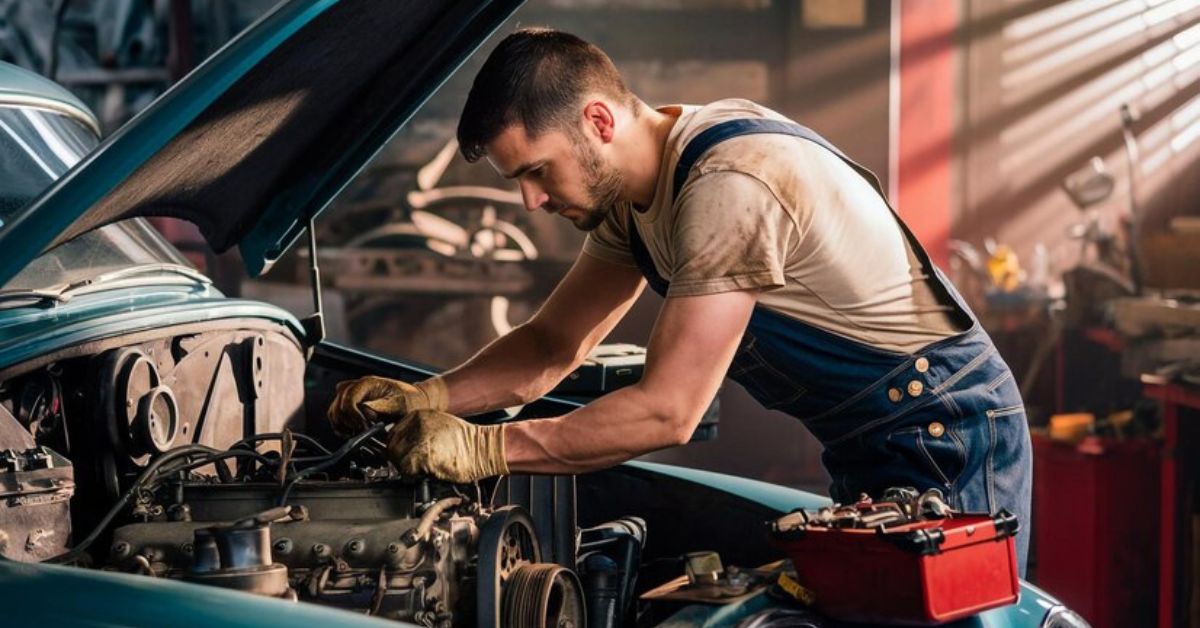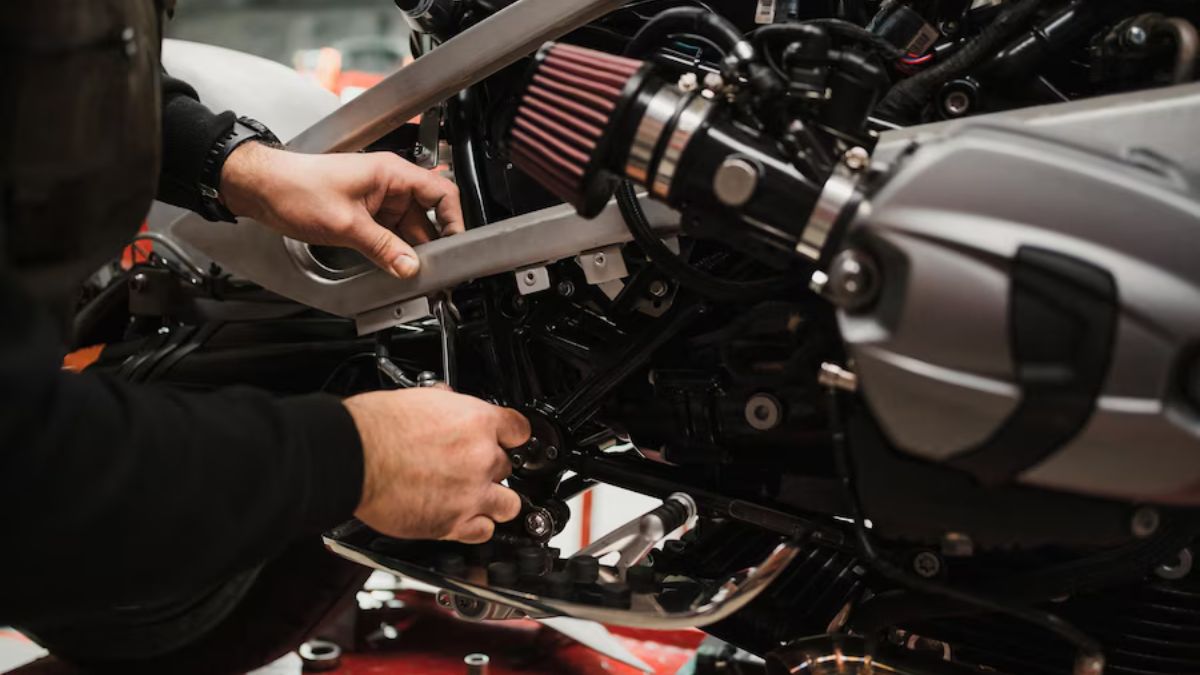AUTOMOTIVE
The Essential Guide to Becoming an Automotive Mechanic

Becoming an automotive mechanic is more than just a career; it’s a journey into the heart of the automotive world. Whether you’re passionate about cars or seeking a stable and rewarding career, this guide is designed to walk you through everything you need to know. From understanding the basic qualifications to mastering the skills needed for success, we’ll cover it all in a way that’s engaging and easy to follow.
Understanding the Role of an Automotive Mechanic
Automotive mechanics are the backbone of the automotive industry. They diagnose, repair, and maintain vehicles, ensuring that everything from a family sedan to a high-performance sports car runs smoothly. The role requires a blend of technical know-how, hands-on skills, and a deep understanding of automotive systems.
Why Choose a Career as an Automotive Mechanic?
The automotive industry is ever-evolving, and with it, the demand for skilled mechanics continues to grow. This career offers stability, a good income, and the satisfaction of solving problems and working with your hands. Whether you’re fresh out of school or looking to make a career change, becoming an automotive mechanic can be a fulfilling path.
Educational Pathways to Becoming an Automotive Mechanic
While some mechanics learn on the job, formal education can provide a solid foundation. Many community colleges and technical schools offer programs in automotive technology. These programs typically cover everything from engine repair to electronic systems, giving you the skills needed to succeed.
Certifications and Licensing
Certification can set you apart in the competitive world of automotive repair. Organizations like the National Institute for Automotive Service Excellence (ASE) offer certifications that demonstrate your expertise. Many employers require ASE certification, and it can lead to better job opportunities and higher pay.
Gaining Hands-On Experience
While classroom learning is essential, hands-on experience is where you’ll truly hone your skills. Internships, apprenticeships, or entry-level positions in repair shops can provide valuable experience. Working under experienced mechanics allows you to learn the trade in a real-world setting, making you more confident and capable.
Mastering Essential Skills
To succeed as an automotive mechanic, you’ll need to master a wide range of skills. These include diagnosing problems using computerized equipment, repairing and replacing parts, and understanding complex mechanical and electronic systems. Attention to detail, problem-solving abilities, and manual dexterity are also crucial.
The Importance of Customer Service
While technical skills are vital, don’t underestimate the importance of customer service. As a mechanic, you’ll interact with customers regularly. Being able to explain repairs clearly and honestly can build trust and lead to repeat business. Good communication skills can set you apart in a field where word-of-mouth referrals are essential.
Staying Updated with Industry Trends
The automotive industry is continuously evolving, with new technologies and advancements emerging regularly. Staying updated with industry trends is vital for any automotive mechanic. Whether it’s electric vehicles, hybrid technology, or advanced diagnostic tools, continuous learning is key to staying competitive.
Starting Your Own Automotive Repair Business
For those with an entrepreneurial spirit, starting your own repair shop can be an exciting venture. It requires not only mechanical expertise but also business acumen. You’ll need to understand everything from marketing and customer service to inventory management and financial planning.
Challenges in the Automotive Mechanic Profession
Like any profession, being an automotive mechanic comes with its challenges. The work can be physically demanding, requiring long hours on your feet. You’ll also need to stay updated with the latest technology, which can be a constant learning curve. However, the rewards often outweigh the challenges, especially for those passionate about cars.
Career Growth and Opportunities
The career of an automotive mechanic offers numerous growth opportunities. With experience and additional certifications, you can move into specialized areas such as performance tuning, diesel mechanics, or even teaching and training. The possibilities are vast, and the potential for career advancement is significant.
Salary Expectations
The salary of an automotive mechanic can vary depending on experience, location, and specialization. Entry-level positions may start around $30,000 per year, while experienced mechanics can earn upwards of $60,000 or more. Specialized mechanics, particularly in high-demand areas, can command even higher salaries.
Work-Life Balance in the Automotive Industry
Work-life balance is an essential consideration for anyone in the automotive industry. While the work can be demanding, many mechanics find that it offers a good balance between professional and personal life. Flexible hours, particularly for those who start their own business, can make it easier to achieve a fulfilling work-life balance.
The Future of Automotive Mechanics
The future of automotive mechanics is bright, with continued demand for skilled professionals. As technology advances, the role of the mechanic will continue to evolve, requiring ongoing education and adaptation. Those who embrace these changes will find ample opportunities for growth and success.
Conclusion
Becoming an automotive mechanic is a rewarding and challenging career path that offers stability, growth, and the satisfaction of working with your hands. By understanding the role, pursuing the right education and certifications, and continually honing your skills, you can build a successful career in this dynamic field.
FAQs
Q: How long does it take to become an automotive mechanic?
The time it takes can vary, but most people complete their training and certification within 2-3 years, including hands-on experience.
Q: Do I need a college degree to become an automotive mechanic?
While a college degree isn’t required, formal education through a technical school can provide valuable knowledge and skills.
Q: What tools do automotive mechanics use?
Mechanics use a wide range of tools, including wrenches, screwdrivers, diagnostic equipment, and specialized tools for specific repairs.
Q: Is certification necessary to work as an automotive mechanic?
Certification, such as ASE certification, is not always required but can significantly enhance job prospects and earning potential.
Q: Can automotive mechanics specialize in specific types of vehicles?
Yes, mechanics can specialize in areas such as diesel engines, high-performance vehicles, or specific brands, which can lead to higher pay and more job opportunities.

AUTOMOTIVE
Exploring the Power and Prestige of the G63MGS: A Deep Dive

When you think of luxury SUVs, one name often rises above the rest: the G63MGS. This iconic vehicle is more than just a mode of transportation; it’s a statement on wheels. With its muscular design and unrivaled performance, the G63MGS captures attention wherever it goes. It seamlessly blends power with prestige, making it an object of desire for automotive enthusiasts and everyday drivers alike.
But what makes the G63MGS stand out in a crowded market? Is it its rich history, innovative features, or perhaps its undeniable allure? Join us as we delve deep into the world of the G63MGS to uncover what truly sets this remarkable SUV apart. Whether you’re a long-time fan or new to this powerhouse, there’s something captivating waiting for you. Let’s explore!
The History and Evolution of the G63MGS
The G63MGS has a rich history that stretches back to its roots in the iconic Mercedes-Benz G-Class. Originally launched in 1979, this rugged vehicle was designed for military use and quickly transitioned into civilian markets.
Over the years, it evolved from a utilitarian workhorse into a luxurious yet powerful SUV. The introduction of high-performance variants like the G63 brought sportier aesthetics and advanced technology to an already capable platform.
In 2012, AMG took over with significant enhancements. They boosted performance while maintaining the classic charm that fans adore.
With each generation, features were refined—smart infotainment systems emerged alongside plush interiors. The balance between luxury and off-road capability became even more pronounced.
Today’s G63MGS stands as a testament to innovation while honoring its storied past, appealing to both thrill-seekers and those who crave sophistication on wheels.
Design and Features of the G63MGS
The G63MGS commands attention with its bold design. Its muscular stance and iconic boxy silhouette set it apart from other SUVs on the market. Every angle exudes confidence, making a statement wherever it goes.
Inside, luxury meets functionality. High-quality materials adorn every surface, creating an inviting atmosphere for passengers and driver alike. The dashboard features cutting-edge technology seamlessly integrated into the sleek design.
Versatility is key in this vehicle. Ample cargo space allows for practical use while maintaining elegance. Ambient lighting adds a touch of sophistication to night drives.
Safety is paramount and the G63MGS excels here too. Advanced driver-assistance systems enhance security without compromising style or comfort.
From its commanding exterior to its luxurious interior, each feature reflects careful craftsmanship designed for those who appreciate both power and prestige in one stunning package.
Performance and Power of the G63MGS
The G63MGS is not just a vehicle; it’s an experience. Under the hood, this beast houses a formidable twin-turbo V8 engine that delivers exhilarating power with every press of the pedal.
Acceleration is another realm altogether. The G63MGS can sprint from 0 to 60 mph in mere seconds. This performance isn’t just about speed; it’s about sheer force and control on any terrain.
Off-road capabilities add another layer of excitement. With advanced traction systems and robust suspension, tackling rugged landscapes feels effortless. Whether you’re navigating city streets or conquering mountain trails, the G63MGS excels.
Drivers often rave about its handling precision as well. The integration of cutting-edge technology ensures a smooth ride while maintaining agility at higher speeds.
Fueling your sense of adventure has never been so thrilling than behind the wheel of the G63MGS, where power meets elegance in perfect harmony.
Prestige and Popularity of the G63MGS
The G63MGS has emerged as a symbol of luxury and power. Its bold exterior commands attention, while its interior exudes comfort and sophistication. This vehicle is not just a mode of transport; it’s an experience.
High-profile celebrities and influencers often showcase their G63MGS on social media platforms, further enhancing its allure. Each post contributes to the growing mystique surrounding this incredible machine.
Additionally, owning a G63MGS isn’t merely about having a car; it signifies status in society. It represents success and achievement, appealing to those who value both performance and prestige.
As urban landscapes become more crowded with standard vehicles, the unique design of the G63MGS stands out distinctly. This exclusivity makes it even more sought after among enthusiasts looking for something extraordinary in their daily drive.
Personal Testimonials from G63MGS Owners
G63MGS owners often rave about their experiences. Many describe the feeling of commanding such a powerful vehicle. The growl of the engine alone turns heads on city streets and rugged terrains alike.
One owner shared how driving the G63MGS feels like an adventure every day. They appreciate its blend of luxury and capability, making it perfect for both urban commutes and off-road escapades.
Another enthusiast highlighted the interior design as a major draw. The premium materials, advanced tech features, and spacious cabin create an inviting atmosphere that enhances every journey.
Owners also value the sense of community that comes with being part of the G63MGS family. From online forums to local meet-ups, there’s camaraderie among those who own this prestigious SUV.
The power behind each wheel leaves a lasting impression too; many find themselves eager to take longer road trips just to enjoy driving it more.
Maintenance and Upkeep of the G63MGS
Owning a G63MGS comes with the responsibility of maintaining its luxurious appeal and powerful performance. Regular maintenance is key to keeping this beast in prime condition.
Routine oil changes are essential for engine health. It’s advisable to stick with high-quality synthetic oil that meets manufacturer specifications. Fluid checks, including brake and transmission fluids, are equally important.
Tire care cannot be overlooked either. Regular rotations and ensuring optimal pressure contribute significantly to handling and safety.
The interior deserves attention too. Cleaning leather seats with appropriate products helps maintain their luster while protecting against wear over time.
Don’t forget about software updates. The G63MGS often features advanced technology that benefits from regular upgrades, enhancing both performance and user experience on the road.
Competitors to the G63MGS
The G63MGS faces tough competition in the luxury SUV market. Brands like the Land Rover Range Rover Sport are formidable contenders. Known for their off-road capabilities and plush interiors, they attract adventure seekers with a taste for elegance.
Another rival is the BMW X7. This model offers a blend of performance and sophistication that appeals to families needing space without sacrificing style. Its tech-savvy features are also hard to ignore.
Then there’s the Porsche Cayenne, revered for its sporty handling and powerful engine options. Enthusiasts appreciate its driving dynamics, which set it apart from traditional SUVs.
Don’t overlook the Lamborghini Urus. With its striking design and roaring V8 engine, it delivers an exhilarating driving experience while making a bold statement on any road.
Each competitor brings unique attributes that challenge the allure of the G63MGS in different ways.
Future of the G63MGS
The future of the G63MGS looks incredibly promising. As automotive technology advances, so does the potential for this iconic vehicle. With electric and hybrid models gaining popularity, enthusiasts are eager to see how Mercedes-Benz integrates these innovations into the G-Class lineup.
Sustainability is becoming a focal point in luxury vehicles. The G63MGS may soon embrace greener technologies without sacrificing its powerful performance or rugged charm. This evolution could redefine what it means to be both luxurious and environmentally conscious.
Moreover, advancements in autonomous driving tech might find their way into future models. Imagine a G63MGS that combines off-road prowess with cutting-edge driver-assistance features.
As demand continues to rise globally, Mercedes-Benz will likely invest more resources into enhancing customization options. Personalization has become a key trend among buyers seeking unique vehicles that reflect their individual styles and preferences.
Conclusion
The G63MGS stands as a remarkable blend of power, luxury, and heritage. Its storied past reflects not just a vehicle but an icon that has evolved over decades to meet the demands of modern drivers while retaining its classic charm.
With standout design features and impressive performance metrics, it captures attention on any road. The prestige associated with owning a G63MGS is palpable; it’s more than just transportation—it’s a statement. Owners rave about their experiences, often highlighting the unique combination of comfort and capability this SUV offers.
Maintenance may require diligence, yet many find that it’s well worth the effort for such a distinguished vehicle. Competing models exist in the market; however, few can match what the G63MGS brings to both everyday utility and status symbol appeal.
Looking ahead, one can only speculate how Mercedes-Benz will continue to innovate within this beloved model line. But one thing remains certain: the G63MGS will always hold its place at the forefront of automotive excellence.
AUTOMOTIVE
How to Turn Engine Manually on a Vstar 1600: An Inside Look

How to Turn Engine Manually on a Vstar 1600; it’s a blend of power, style, and craftsmanship that riders cherish. Whether you’re cruising down the highway or navigating through city streets, this bike delivers an exhilarating experience. However, there may come a time when you need to turn your engine manually—a skill every Vstar owner should master.
Understanding how to turn the engine manually on your Vstar 1600 not only enhances your riding experience but also equips you with essential knowledge for maintenance and troubleshooting. It’s about taking command of your machine in situations where starting issues can arise unexpectedly. Ready to dive deeper? Let’s explore why manual ignition matters and guide you through the process step by step!
Understanding the Importance of Turning Engine Manually
Turning the engine manually on a Vstar 1600 is an essential skill for any motorcycle enthusiast. It allows you to check critical components without relying solely on electrical systems.
Manual rotation helps in assessing the condition of the valves and pistons. You can detect potential issues, such as misalignment or wear before they escalate into costly repairs.
Additionally, turning the engine enables better lubrication distribution. This practice ensures that oil reaches all necessary parts during maintenance checks.
Many riders overlook this simple yet crucial task. By taking control of your engine’s health, you enhance performance and longevity.
Moreover, understanding how to turn your engine manually builds confidence in tackling more complex mechanical issues down the line. Empowering yourself with this knowledge fosters a deeper connection with your Vstar 1600 and its mechanics.
Step-by-Step Guide on How to Turn Engine Manually on a Vstar 1600
To turn the engine manually on a Vstar 1600, start by ensuring your motorcycle is in neutral. This prevents any unexpected movement while you work.
Next, locate the manual crankshaft access point. You might find it near the left side of the engine, typically protected by a cover. Remove this cover carefully to expose the crankshaft.
Using a socket wrench or appropriate tool, attach it to the bolt on the crankshaft. Rotate it gently clockwise. Listen for any unusual sounds; if something doesn’t feel right, stop immediately.
Continue turning until you notice resistance or reach your desired position in the cycle. Reinstall any covers and ensure everything is secure before starting your bike again.
Remember to check all fluids after moving components manually. This ensures your Vstar 1600 operates smoothly when restarted after manual intervention.
Common Mistakes to Avoid
One common mistake when trying to turn the engine manually on a Vstar 1600 is neglecting to check for proper lubrication. Dry components can lead to unnecessary friction and wear.
Another issue is rushing the process. It’s crucial to take your time and follow each step carefully. Hasty actions can result in misalignment or damage.
Many riders also forget to secure the bike properly before starting this procedure. Ensuring stability will prevent accidents and protect both you and your machine.
Some enthusiasts overlook their owner’s manual, which contains valuable insights specific to their model. Ignoring these guidelines could lead you astray or cause confusion during the process.
Using inappropriate tools can create problems down the line. Always select equipment tailored for your Vstar 1600’s specifications to avoid complications later on.
Maintenance and Care for Your Vstar 1600
Proper maintenance is vital for keeping your Vstar 1600 running smoothly. Regular oil changes are essential, as they help lubricate the engine and prevent wear. Check your owner’s manual for recommended intervals.
Tire pressure should be monitored frequently. Properly inflated tires not only enhance performance but also improve safety on the road.
Cleaning your bike regularly helps preserve its aesthetics and functionality. Use a soft cloth to wipe down surfaces, ensuring that dirt and grime don’t accumulate.
Pay attention to brake pads and fluid levels as well. These components are crucial for safe riding, so inspect them often.
Don’t overlook battery care. A clean and fully charged battery contributes significantly to reliable starting performance while reducing the risk of electrical issues later on.
Conclusion
The Vstar 1600 is a remarkable motorcycle that offers both style and power. Understanding how to turn the engine manually can be a game changer, especially in situations where you may face electrical issues or other complications.
Turning the engine manually isn’t just about getting it started; it’s about ensuring your bike runs smoothly. By following the step-by-step guide provided, you’ll gain confidence in handling this essential task. Remember to take your time and focus on each step.
Avoiding common mistakes will save you time and frustration down the road. Regular maintenance of your Vstar 1600 keeps it in top shape, allowing for easier manual starts whenever needed.
Mastering these skills not only enhances your riding experience but also deepens your connection with your motorcycle. The more familiar you become with its workings, the better prepared you’ll be for any challenges that arise on the road ahead.
-

 NEWS1 year ago
NEWS1 year agoTsumino-Blog.com: A Hub for Manga and Doujinshi Enthusiasts
-

 FASHION1 year ago
FASHION1 year agoFormal One Piece Swimwear
-

 CRYPTO1 year ago
CRYPTO1 year agoHow Crypto30x.com Zeus is Revolutionizing Cryptocurrency Trading
-

 ENTERTAINMENT1 year ago
ENTERTAINMENT1 year agoSimplify Your System with Plugbox Linux: A Lightweight Arch-Based Distro
-

 TECHNOLOGY1 year ago
TECHNOLOGY1 year agoVy6ys: Exploring the Latest Breakthrough in Tech Innovation
-

 ENTERTAINMENT1 year ago
ENTERTAINMENT1 year agoPirlo TV: The Ultimate Guide to Free Online Sports Streaming
-

 NEWS1 year ago
NEWS1 year agoDiscover Ontpresscom: Redefining Online Publishing
-

 HOME1 year ago
HOME1 year agoThe Ultimate Basement Renovation Checklist: Steps to Follow